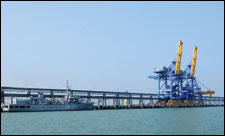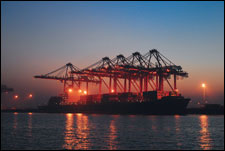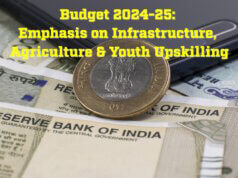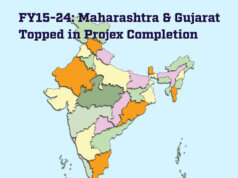 The challenges in the Indian ports sector can be eliminated only with the support of both the central and state governments. However, the Government of India needs to ensure that it supports in every way possible the development and growth of upcoming greenfield and private port projects, says Vijay Kalantri, Chairman & Managing Director, Dighi Port Ltd, which is developing a Port SEZ in Maharashtra.
The challenges in the Indian ports sector can be eliminated only with the support of both the central and state governments. However, the Government of India needs to ensure that it supports in every way possible the development and growth of upcoming greenfield and private port projects, says Vijay Kalantri, Chairman & Managing Director, Dighi Port Ltd, which is developing a Port SEZ in Maharashtra.
Until the 1990s, the Indian port sector was dominated by ports owned by the Government of India. However, with liberalisation measures being initiated in the port sector from the mid-1990s and proactive policies being adopted by states like Gujarat, the share of the private sector in the port sector development has been increasing gradually over the years.
|
The private sector today plays a number of roles such as implementing and developing greenfield port projects, developing and operating terminals at major ports under build-own-transfer (BOT) schemes, port-rail connectivity projects, and providing port support services.
Private sector participation in India’s port sector has been on the increase during the past one decade with the Government of India and a few state governments taking several initiatives to encourage private investment in port development. However, despite the initiatives taken by the government, the private players continue to face several challenges, including a protracted approval process, stiff bidder selection criteria, and certain issues associated with the Model Concession Agreement and with tariff setting.
The other issues that impact the private sector port projects include market risks, operational risks stemming from delays in port connectivity, high cost of capital and maintenance dredging, and funding risks arising from lack of adequate availability of long-term loans.
 Some of the other challenges faced by private ports are listed below:
Some of the other challenges faced by private ports are listed below:
High market risks for greenfield ports: Port development is a highly capital intensive process and, the debt servicing burden is quite high after the initial moratorium period. Thus, it is essential for traffic scale-up to happen quickly for a company to be able to meet its debt servicing obligations. Traffic scale-up takes time, since the market risks associated with the projects are quite high as this could be attributed to susceptibility to global economic cycles.
Absence of anchor customers: The process of weaning customers away from an existing and nearby port may be a long and tiresome affair. Greenfield ports are now adopting the model of having a few anchor customers where cargo volumes are assured through long-term contracts ensuring volume commitments and stability in cash flows. However, most of the new ports have not been able to rope in anchor customers.
Delay in port-road-rail connectivity projects: Tariffs of most greenfield and private ports are higher as compared to major ports because of the higher capital costs involved in the development of new port projects. However, the new ports justify the higher tariff by pointing to the savings accruing to port users on the Integrated Logistics Cost, which comprises oceanic freight, port charges, and inland freight. However, delays attributed to providing good connectivity (road and rail) to the hinterland and the rest of the country invariably impact the demand prospects as potential customers may not have the incentive or the confidence to use a new port despite other advantages such as ability to handle large vessels and high level of mechanisation, improved efficiency etc.
Availability of long-tenure project loans: As the gestation period associated with a greenfield port is long, project developers look for long-tenure loans often extending to 15 years. However, barring a few, the appetite of Indian lenders for long-term loans is low. Hence, some developers are forced to settle for slightly shorter maturity project loans, thereby exposing themselves to refinancing risk.
 Enhancing port infrastructure: Increased emphasis on upgrading both, seaside and landside infrastructure to enhance draft and evacuation procedures would enable universal smoother cargo flows from larger vessels. Improved level of mechanisation via upgrading material-handling equipment and enhanced proper IT infrastructure should be build to ensure electronic flow of information among various stakeholders.
Enhancing port infrastructure: Increased emphasis on upgrading both, seaside and landside infrastructure to enhance draft and evacuation procedures would enable universal smoother cargo flows from larger vessels. Improved level of mechanisation via upgrading material-handling equipment and enhanced proper IT infrastructure should be build to ensure electronic flow of information among various stakeholders.
Improve capacity utilisation: For ports that are potentially limited by the hinterland, the focus needs to be on operational efficiency, which can help such ports remain competitive vis-à-vis larger ports and have a compelling proposition for customers. This would also enable them to remain profitable at low traffic volumes.
Environmental clearances: Easing and speeding up the process of getting environmental clearances for upcoming port projects. The introduction of single-window clearance procedures at the central and state government level would encourage greenfield projects, thereby reducing long gestation periods.
As can be seen from the above the challenges are a plenty. These challenges can be eliminated only with the support of both the central as well as the respective state governments. The government needs to ensure that it supports in every way possible the development and growth of upcoming greenfield port projects as well private ports. The process of land acquisition needs to be expedited, the developer approval process simplified, and the issues associated with Model Concession Agreement addressed. As for private sector ports, faster implementation of connectivity projects would be required if the true potential of these ports is to be realised.











